Analysis of Linear and Non-Linear Phonologies in Linguistics
VerifiedAdded on 2022/08/26
|6
|1341
|33
Report
AI Summary
This report provides a comprehensive analysis of linear and non-linear phonologies, crucial concepts in linguistics. It begins by defining a phoneme and its role in language, then contrasts linear phonology, which emphasizes sequential sound segments, distinctive features, and sound sequences, with non-linear phonology, which focuses on more complex parameters like auto-segmental changes and syllable structures. The report highlights the importance of understanding both approaches for a holistic view of phonology, covering topics such as assimilation, allophones, and the organization of segments within words. References to key texts and theories are included, offering a detailed exploration of the subject matter. The study also analyzes the clinical significance and application of both the phonologies in the field of linguistics. The report also talks about the theoretical approaches that are considered linear phonologies such as distinctive theory, generative phonology and natural phonology.
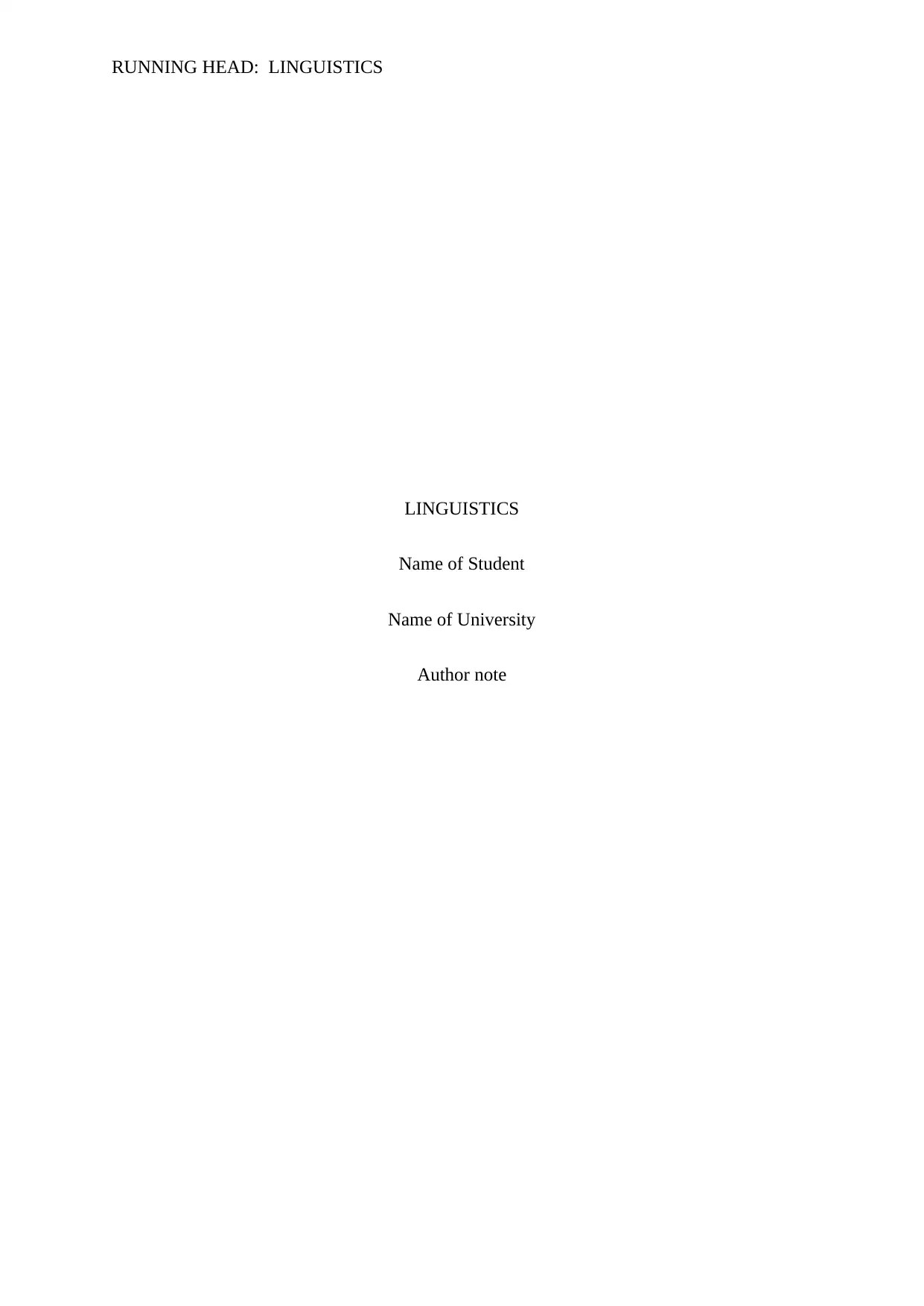
RUNNING HEAD: LINGUISTICS
LINGUISTICS
Name of Student
Name of University
Author note
LINGUISTICS
Name of Student
Name of University
Author note
Paraphrase This Document
Need a fresh take? Get an instant paraphrase of this document with our AI Paraphraser
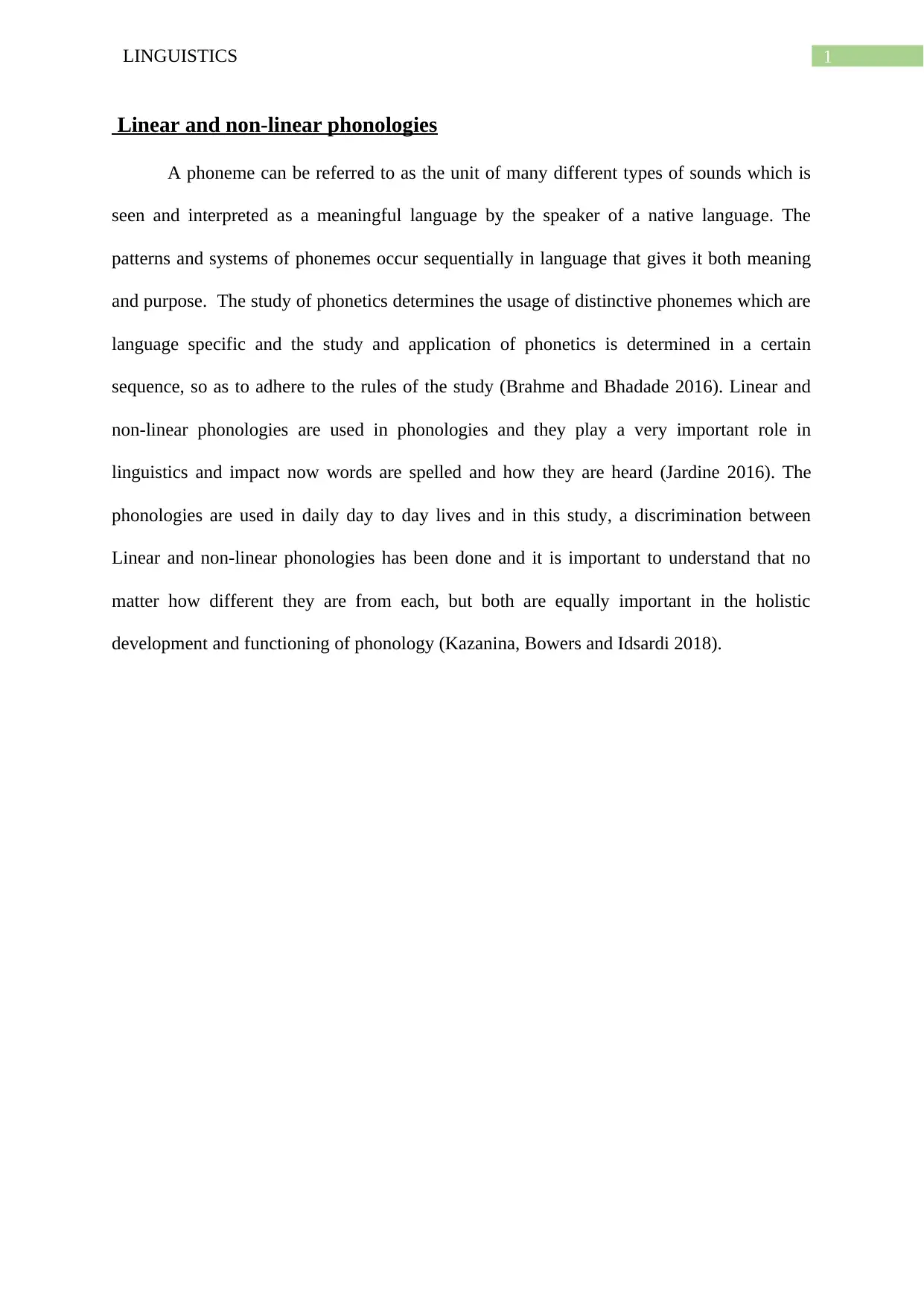
1LINGUISTICS
Linear and non-linear phonologies
A phoneme can be referred to as the unit of many different types of sounds which is
seen and interpreted as a meaningful language by the speaker of a native language. The
patterns and systems of phonemes occur sequentially in language that gives it both meaning
and purpose. The study of phonetics determines the usage of distinctive phonemes which are
language specific and the study and application of phonetics is determined in a certain
sequence, so as to adhere to the rules of the study (Brahme and Bhadade 2016). Linear and
non-linear phonologies are used in phonologies and they play a very important role in
linguistics and impact now words are spelled and how they are heard (Jardine 2016). The
phonologies are used in daily day to day lives and in this study, a discrimination between
Linear and non-linear phonologies has been done and it is important to understand that no
matter how different they are from each, but both are equally important in the holistic
development and functioning of phonology (Kazanina, Bowers and Idsardi 2018).
Linear and non-linear phonologies
A phoneme can be referred to as the unit of many different types of sounds which is
seen and interpreted as a meaningful language by the speaker of a native language. The
patterns and systems of phonemes occur sequentially in language that gives it both meaning
and purpose. The study of phonetics determines the usage of distinctive phonemes which are
language specific and the study and application of phonetics is determined in a certain
sequence, so as to adhere to the rules of the study (Brahme and Bhadade 2016). Linear and
non-linear phonologies are used in phonologies and they play a very important role in
linguistics and impact now words are spelled and how they are heard (Jardine 2016). The
phonologies are used in daily day to day lives and in this study, a discrimination between
Linear and non-linear phonologies has been done and it is important to understand that no
matter how different they are from each, but both are equally important in the holistic
development and functioning of phonology (Kazanina, Bowers and Idsardi 2018).
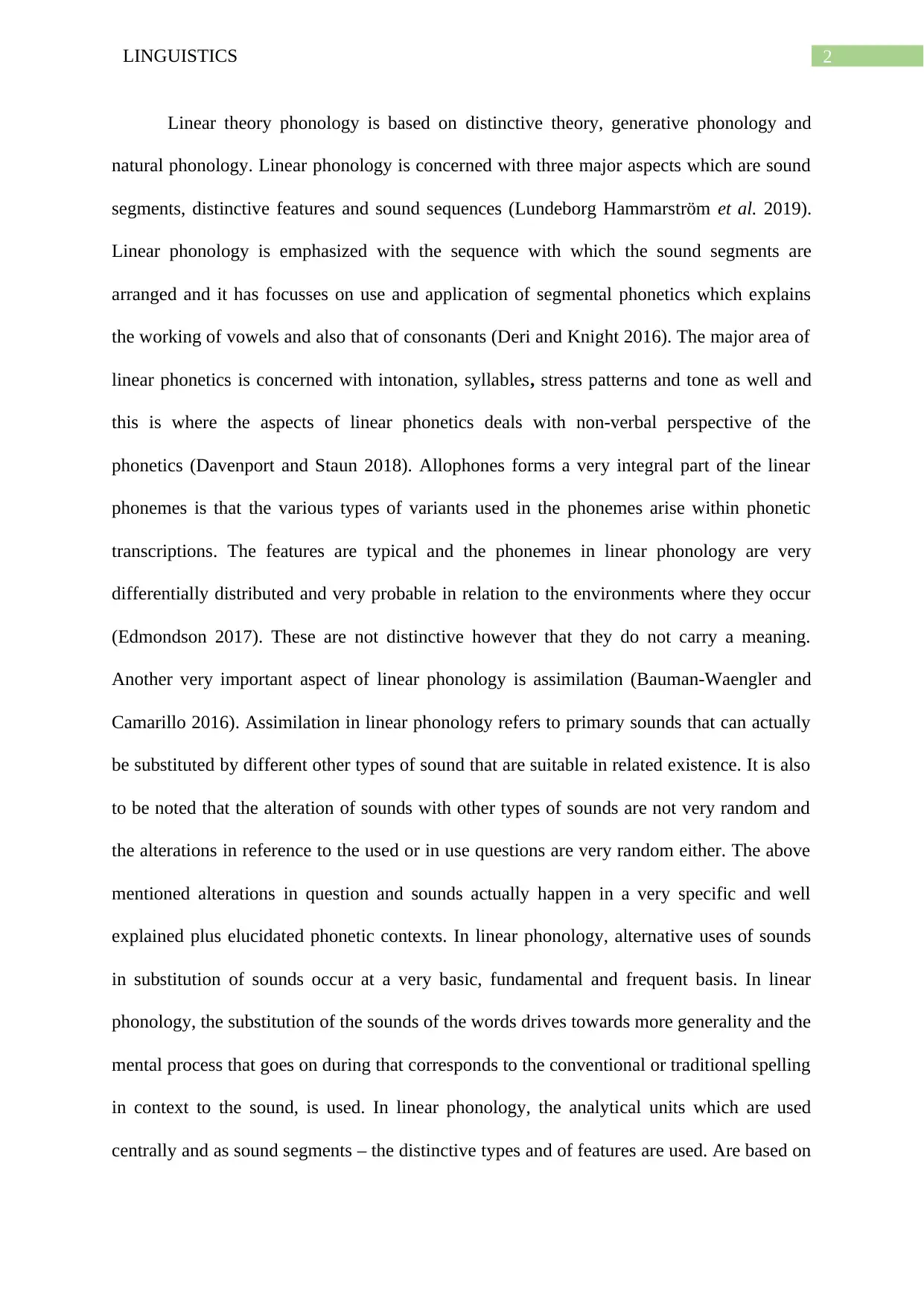
2LINGUISTICS
Linear theory phonology is based on distinctive theory, generative phonology and
natural phonology. Linear phonology is concerned with three major aspects which are sound
segments, distinctive features and sound sequences (Lundeborg Hammarström et al. 2019).
Linear phonology is emphasized with the sequence with which the sound segments are
arranged and it has focusses on use and application of segmental phonetics which explains
the working of vowels and also that of consonants (Deri and Knight 2016). The major area of
linear phonetics is concerned with intonation, syllables, stress patterns and tone as well and
this is where the aspects of linear phonetics deals with non-verbal perspective of the
phonetics (Davenport and Staun 2018). Allophones forms a very integral part of the linear
phonemes is that the various types of variants used in the phonemes arise within phonetic
transcriptions. The features are typical and the phonemes in linear phonology are very
differentially distributed and very probable in relation to the environments where they occur
(Edmondson 2017). These are not distinctive however that they do not carry a meaning.
Another very important aspect of linear phonology is assimilation (Bauman-Waengler and
Camarillo 2016). Assimilation in linear phonology refers to primary sounds that can actually
be substituted by different other types of sound that are suitable in related existence. It is also
to be noted that the alteration of sounds with other types of sounds are not very random and
the alterations in reference to the used or in use questions are very random either. The above
mentioned alterations in question and sounds actually happen in a very specific and well
explained plus elucidated phonetic contexts. In linear phonology, alternative uses of sounds
in substitution of sounds occur at a very basic, fundamental and frequent basis. In linear
phonology, the substitution of the sounds of the words drives towards more generality and the
mental process that goes on during that corresponds to the conventional or traditional spelling
in context to the sound, is used. In linear phonology, the analytical units which are used
centrally and as sound segments – the distinctive types and of features are used. Are based on
Linear theory phonology is based on distinctive theory, generative phonology and
natural phonology. Linear phonology is concerned with three major aspects which are sound
segments, distinctive features and sound sequences (Lundeborg Hammarström et al. 2019).
Linear phonology is emphasized with the sequence with which the sound segments are
arranged and it has focusses on use and application of segmental phonetics which explains
the working of vowels and also that of consonants (Deri and Knight 2016). The major area of
linear phonetics is concerned with intonation, syllables, stress patterns and tone as well and
this is where the aspects of linear phonetics deals with non-verbal perspective of the
phonetics (Davenport and Staun 2018). Allophones forms a very integral part of the linear
phonemes is that the various types of variants used in the phonemes arise within phonetic
transcriptions. The features are typical and the phonemes in linear phonology are very
differentially distributed and very probable in relation to the environments where they occur
(Edmondson 2017). These are not distinctive however that they do not carry a meaning.
Another very important aspect of linear phonology is assimilation (Bauman-Waengler and
Camarillo 2016). Assimilation in linear phonology refers to primary sounds that can actually
be substituted by different other types of sound that are suitable in related existence. It is also
to be noted that the alteration of sounds with other types of sounds are not very random and
the alterations in reference to the used or in use questions are very random either. The above
mentioned alterations in question and sounds actually happen in a very specific and well
explained plus elucidated phonetic contexts. In linear phonology, alternative uses of sounds
in substitution of sounds occur at a very basic, fundamental and frequent basis. In linear
phonology, the substitution of the sounds of the words drives towards more generality and the
mental process that goes on during that corresponds to the conventional or traditional spelling
in context to the sound, is used. In linear phonology, the analytical units which are used
centrally and as sound segments – the distinctive types and of features are used. Are based on
⊘ This is a preview!⊘
Do you want full access?
Subscribe today to unlock all pages.

Trusted by 1+ million students worldwide
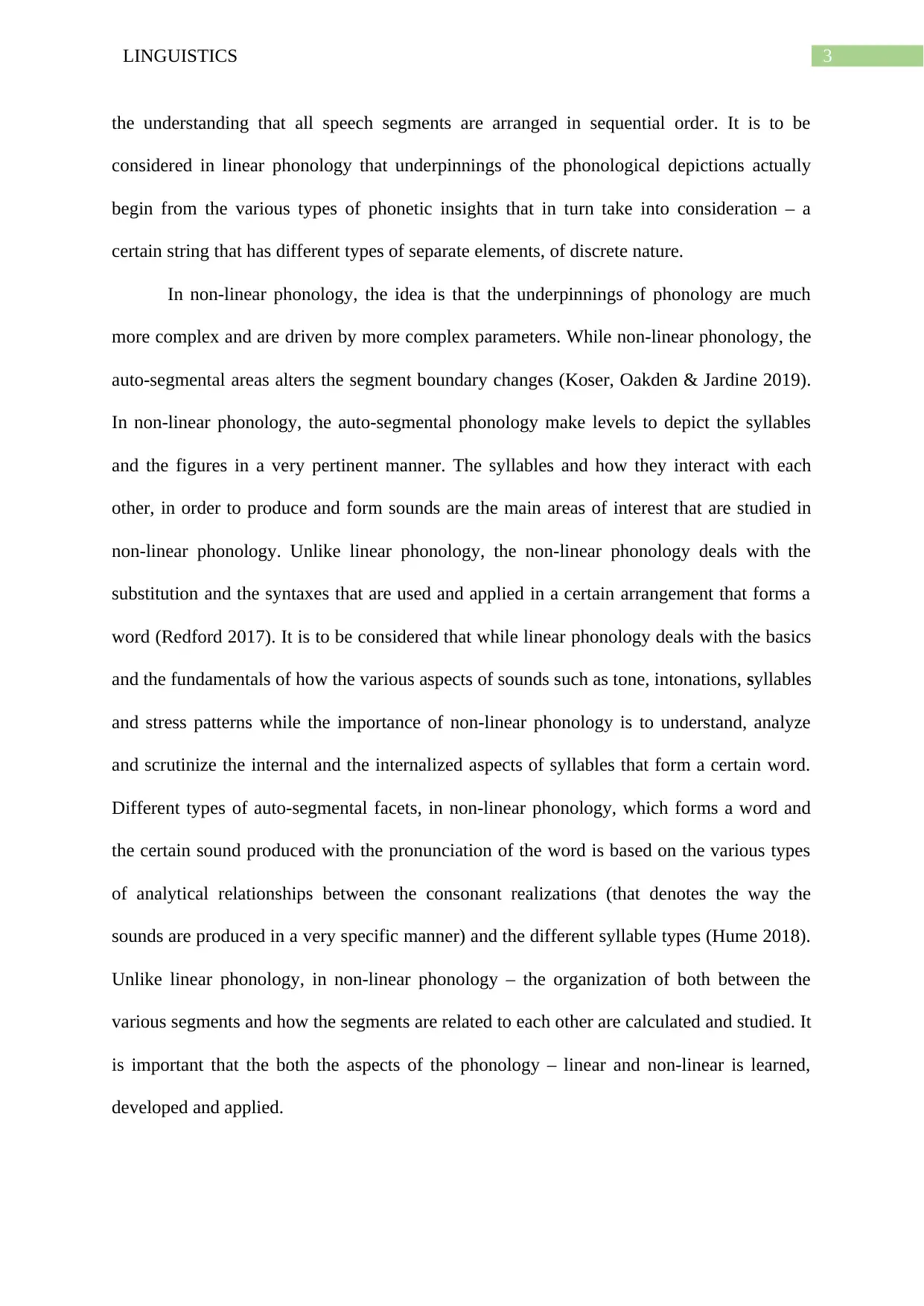
3LINGUISTICS
the understanding that all speech segments are arranged in sequential order. It is to be
considered in linear phonology that underpinnings of the phonological depictions actually
begin from the various types of phonetic insights that in turn take into consideration – a
certain string that has different types of separate elements, of discrete nature.
In non-linear phonology, the idea is that the underpinnings of phonology are much
more complex and are driven by more complex parameters. While non-linear phonology, the
auto-segmental areas alters the segment boundary changes (Koser, Oakden & Jardine 2019).
In non-linear phonology, the auto-segmental phonology make levels to depict the syllables
and the figures in a very pertinent manner. The syllables and how they interact with each
other, in order to produce and form sounds are the main areas of interest that are studied in
non-linear phonology. Unlike linear phonology, the non-linear phonology deals with the
substitution and the syntaxes that are used and applied in a certain arrangement that forms a
word (Redford 2017). It is to be considered that while linear phonology deals with the basics
and the fundamentals of how the various aspects of sounds such as tone, intonations, syllables
and stress patterns while the importance of non-linear phonology is to understand, analyze
and scrutinize the internal and the internalized aspects of syllables that form a certain word.
Different types of auto-segmental facets, in non-linear phonology, which forms a word and
the certain sound produced with the pronunciation of the word is based on the various types
of analytical relationships between the consonant realizations (that denotes the way the
sounds are produced in a very specific manner) and the different syllable types (Hume 2018).
Unlike linear phonology, in non-linear phonology – the organization of both between the
various segments and how the segments are related to each other are calculated and studied. It
is important that the both the aspects of the phonology – linear and non-linear is learned,
developed and applied.
the understanding that all speech segments are arranged in sequential order. It is to be
considered in linear phonology that underpinnings of the phonological depictions actually
begin from the various types of phonetic insights that in turn take into consideration – a
certain string that has different types of separate elements, of discrete nature.
In non-linear phonology, the idea is that the underpinnings of phonology are much
more complex and are driven by more complex parameters. While non-linear phonology, the
auto-segmental areas alters the segment boundary changes (Koser, Oakden & Jardine 2019).
In non-linear phonology, the auto-segmental phonology make levels to depict the syllables
and the figures in a very pertinent manner. The syllables and how they interact with each
other, in order to produce and form sounds are the main areas of interest that are studied in
non-linear phonology. Unlike linear phonology, the non-linear phonology deals with the
substitution and the syntaxes that are used and applied in a certain arrangement that forms a
word (Redford 2017). It is to be considered that while linear phonology deals with the basics
and the fundamentals of how the various aspects of sounds such as tone, intonations, syllables
and stress patterns while the importance of non-linear phonology is to understand, analyze
and scrutinize the internal and the internalized aspects of syllables that form a certain word.
Different types of auto-segmental facets, in non-linear phonology, which forms a word and
the certain sound produced with the pronunciation of the word is based on the various types
of analytical relationships between the consonant realizations (that denotes the way the
sounds are produced in a very specific manner) and the different syllable types (Hume 2018).
Unlike linear phonology, in non-linear phonology – the organization of both between the
various segments and how the segments are related to each other are calculated and studied. It
is important that the both the aspects of the phonology – linear and non-linear is learned,
developed and applied.
Paraphrase This Document
Need a fresh take? Get an instant paraphrase of this document with our AI Paraphraser
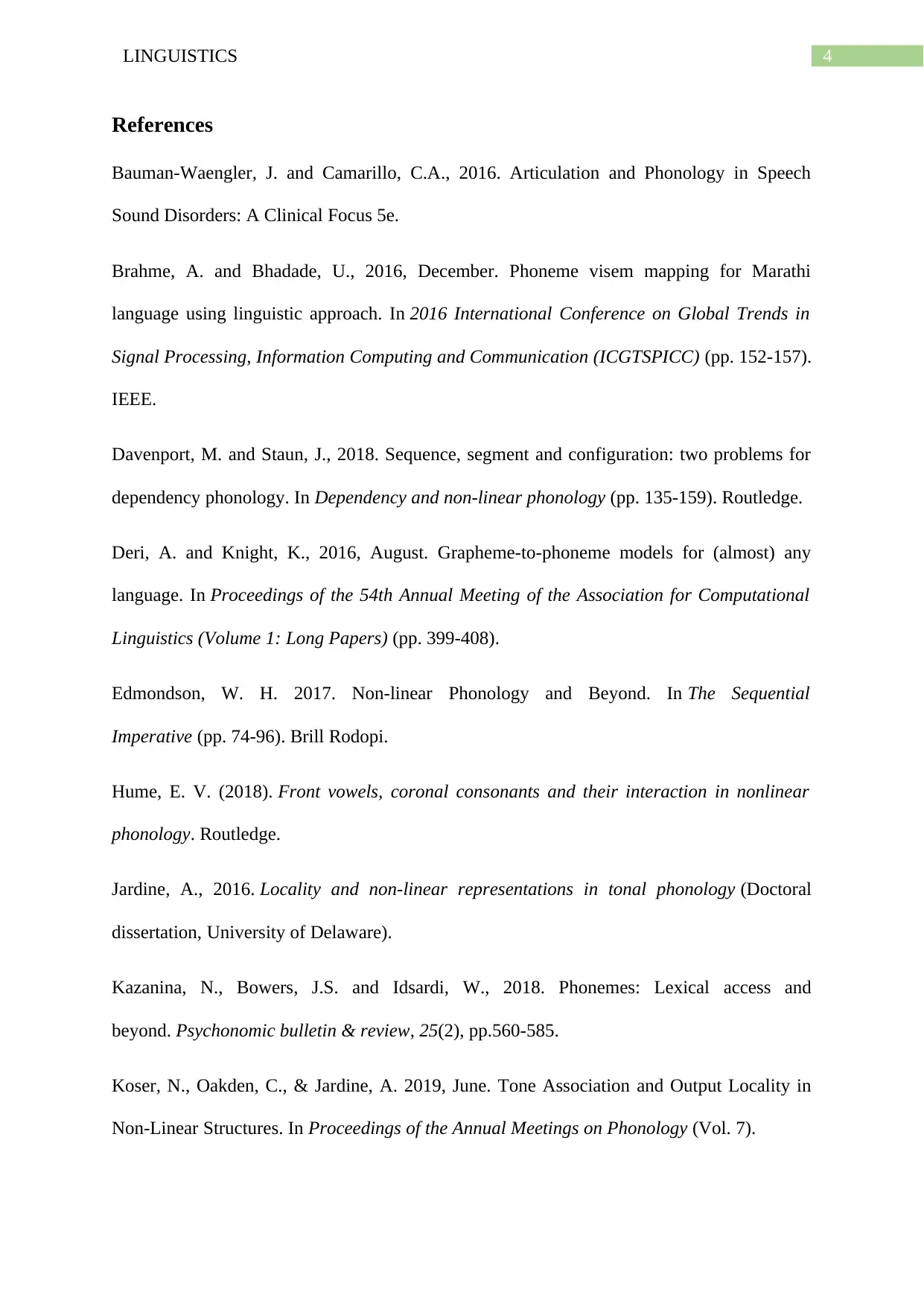
4LINGUISTICS
References
Bauman-Waengler, J. and Camarillo, C.A., 2016. Articulation and Phonology in Speech
Sound Disorders: A Clinical Focus 5e.
Brahme, A. and Bhadade, U., 2016, December. Phoneme visem mapping for Marathi
language using linguistic approach. In 2016 International Conference on Global Trends in
Signal Processing, Information Computing and Communication (ICGTSPICC) (pp. 152-157).
IEEE.
Davenport, M. and Staun, J., 2018. Sequence, segment and configuration: two problems for
dependency phonology. In Dependency and non-linear phonology (pp. 135-159). Routledge.
Deri, A. and Knight, K., 2016, August. Grapheme-to-phoneme models for (almost) any
language. In Proceedings of the 54th Annual Meeting of the Association for Computational
Linguistics (Volume 1: Long Papers) (pp. 399-408).
Edmondson, W. H. 2017. Non-linear Phonology and Beyond. In The Sequential
Imperative (pp. 74-96). Brill Rodopi.
Hume, E. V. (2018). Front vowels, coronal consonants and their interaction in nonlinear
phonology. Routledge.
Jardine, A., 2016. Locality and non-linear representations in tonal phonology (Doctoral
dissertation, University of Delaware).
Kazanina, N., Bowers, J.S. and Idsardi, W., 2018. Phonemes: Lexical access and
beyond. Psychonomic bulletin & review, 25(2), pp.560-585.
Koser, N., Oakden, C., & Jardine, A. 2019, June. Tone Association and Output Locality in
Non-Linear Structures. In Proceedings of the Annual Meetings on Phonology (Vol. 7).
References
Bauman-Waengler, J. and Camarillo, C.A., 2016. Articulation and Phonology in Speech
Sound Disorders: A Clinical Focus 5e.
Brahme, A. and Bhadade, U., 2016, December. Phoneme visem mapping for Marathi
language using linguistic approach. In 2016 International Conference on Global Trends in
Signal Processing, Information Computing and Communication (ICGTSPICC) (pp. 152-157).
IEEE.
Davenport, M. and Staun, J., 2018. Sequence, segment and configuration: two problems for
dependency phonology. In Dependency and non-linear phonology (pp. 135-159). Routledge.
Deri, A. and Knight, K., 2016, August. Grapheme-to-phoneme models for (almost) any
language. In Proceedings of the 54th Annual Meeting of the Association for Computational
Linguistics (Volume 1: Long Papers) (pp. 399-408).
Edmondson, W. H. 2017. Non-linear Phonology and Beyond. In The Sequential
Imperative (pp. 74-96). Brill Rodopi.
Hume, E. V. (2018). Front vowels, coronal consonants and their interaction in nonlinear
phonology. Routledge.
Jardine, A., 2016. Locality and non-linear representations in tonal phonology (Doctoral
dissertation, University of Delaware).
Kazanina, N., Bowers, J.S. and Idsardi, W., 2018. Phonemes: Lexical access and
beyond. Psychonomic bulletin & review, 25(2), pp.560-585.
Koser, N., Oakden, C., & Jardine, A. 2019, June. Tone Association and Output Locality in
Non-Linear Structures. In Proceedings of the Annual Meetings on Phonology (Vol. 7).
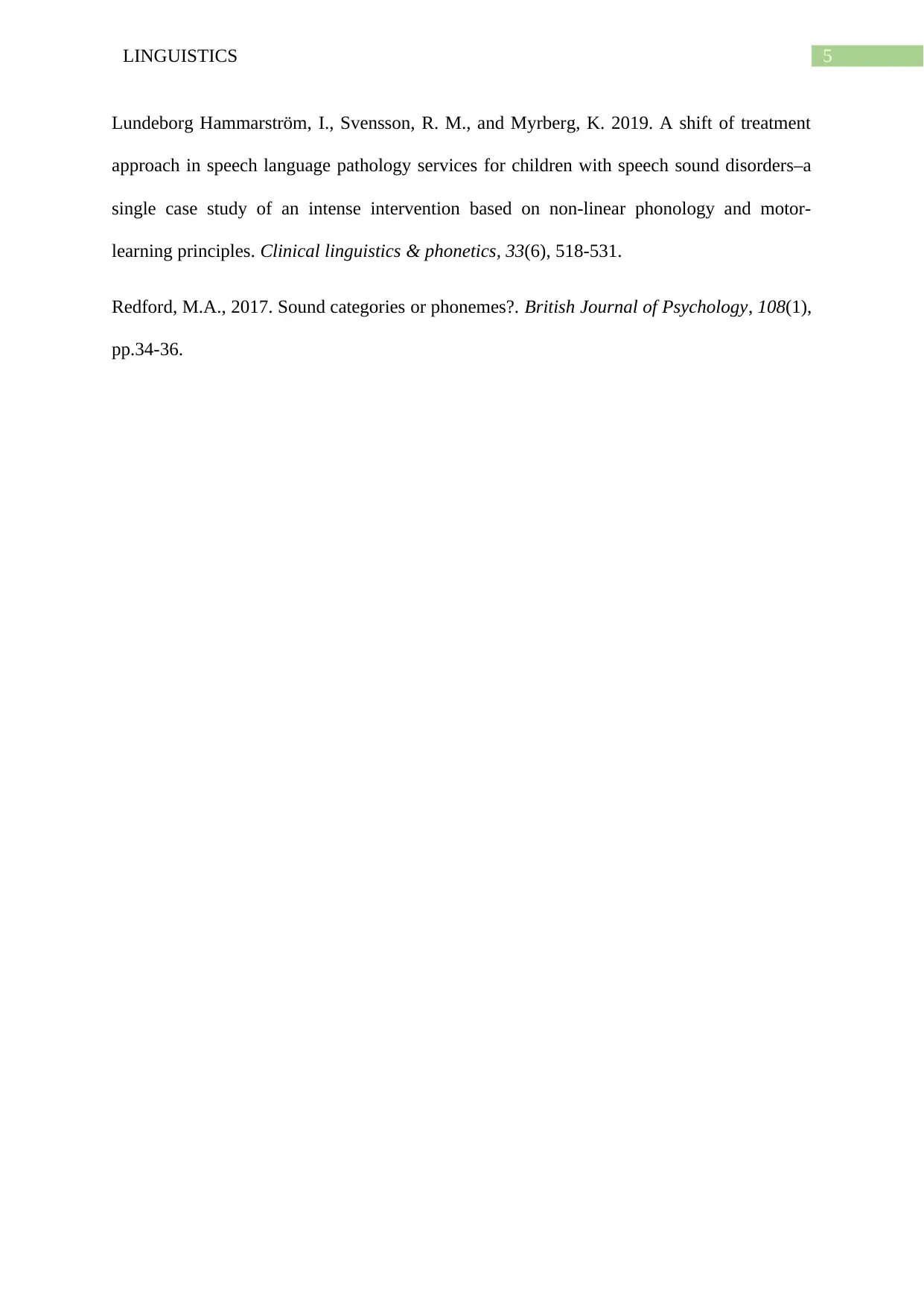
5LINGUISTICS
Lundeborg Hammarström, I., Svensson, R. M., and Myrberg, K. 2019. A shift of treatment
approach in speech language pathology services for children with speech sound disorders–a
single case study of an intense intervention based on non-linear phonology and motor-
learning principles. Clinical linguistics & phonetics, 33(6), 518-531.
Redford, M.A., 2017. Sound categories or phonemes?. British Journal of Psychology, 108(1),
pp.34-36.
Lundeborg Hammarström, I., Svensson, R. M., and Myrberg, K. 2019. A shift of treatment
approach in speech language pathology services for children with speech sound disorders–a
single case study of an intense intervention based on non-linear phonology and motor-
learning principles. Clinical linguistics & phonetics, 33(6), 518-531.
Redford, M.A., 2017. Sound categories or phonemes?. British Journal of Psychology, 108(1),
pp.34-36.
⊘ This is a preview!⊘
Do you want full access?
Subscribe today to unlock all pages.

Trusted by 1+ million students worldwide
1 out of 6
Your All-in-One AI-Powered Toolkit for Academic Success.
+13062052269
info@desklib.com
Available 24*7 on WhatsApp / Email
![[object Object]](/_next/static/media/star-bottom.7253800d.svg)
Unlock your academic potential
Copyright © 2020–2025 A2Z Services. All Rights Reserved. Developed and managed by ZUCOL.

